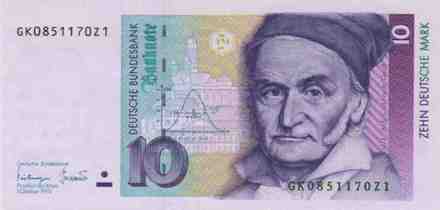
Gauss on 10 German Mark

Concern for man and his fate must always form the chief interest of technical endeavors - Albert Einstein
Euler on 10 Swiss Francs
Euler is also renowned for his work in mechanics, fluid dynamics, optics, and astronomy. Most notably, he introduced the concept of a function and was the first to write f(x) to denote the function f applied to the argument x. He also introduced the modern notation for the trigonometric functions, the letter e for the base of the natural logarithm (now also known as Euler's number), the Greek letter Σ for summations and the letter i to denote the imaginary unit.
Marie Skłodowska Curie (1867 – 1934) was a physicist and chemist of Polish upbringing and, subsequently, French citizenship. She was a pioneer in the field of radioactivity, the first person honored with two Nobel Prizes, receiving one in physics and later, one in chemistry. Her achievements include the creation of a theory of radioactivity techniques for isolating radioactive isotopes, and the discovery of two new elements, polonium and radium. Under her direction, the world's first studies were conducted into the treatment of neoplasms (cancers), using radioactive isotopes.
Pierre Curie (1859 – 1906) was a French physicist, a pioneer in crystallography, magnetism, piezoelectricity and radioactivity, and Nobel laureate. Apart from the nuclear stuff, he discovered that ferromagnetic substances exhibited a critical temperature transition, above which the substances lost their ferromagnetic behavior. This is now known as the Curie point.
Kristian Birkeland (1867 – 1917) was a Norwegian scientist. He is best remembered as the person who first elucidated the nature of the Aurora borealis (The Northern Lights). In order to fund his research on the aurorae, he invented the electromagnetic cannon (weapon) and the Birkeland-Eyde process of fixing nitrogen from the air. In 1913, Birkeland may have been the first to predict that plasma was ubiquitous in space. He developed a theory in which energetic electrons were ejected from sunspots on the solar surface, directed to the Earth, and guided to the Earth's polar regions by the geomagnetic field where they produced the visible aurora.
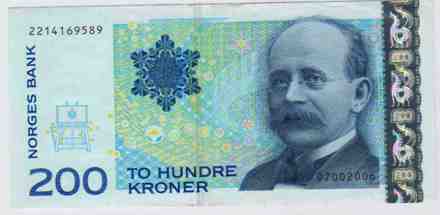
Birkeland is featured on Norway's 200 Kroner note
Marie and Pierre Curie on French 500 Francs
Marie Curie on Polish 20000 Zloty
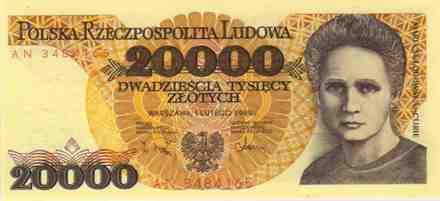
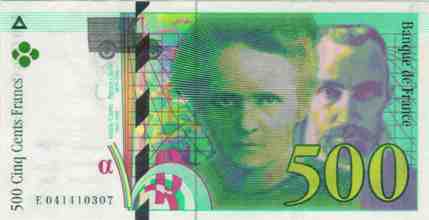
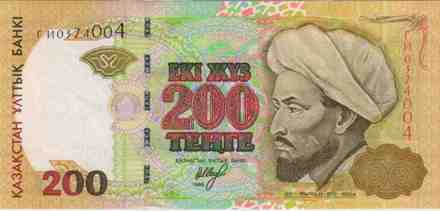
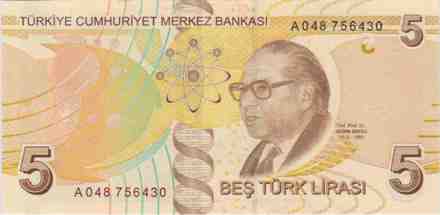
Cahit Arf (1910 – 1997) was a Turkish mathematician known for the Arf Invariant used in topology, a major area of mathematics concerned with spatial properties that are preserved under continuous deformations of objects, for example, deformations that involve stretching, but no tearing or gluing. It emerged through the development of concepts from geometry and set theory, such as space, dimension, and transformation.
Jose Echegaray (1832-1916) was a Spanish mathematician, civil engineer, and the leading Spanish dramatist of the last quarter of the 19th century. Along with the poet Frederic Mistral, he was awarded the Nobel Prize for Literature in 1904. A professor of mathematics in his early life, he entered government service in 1868, holding various positions. He was more like the Bertrand Russell of Spain.
Ibn Khaldoun (1332 AD – 1406 AD) was an Arab polymath - an astronomer, economist, historian, Islamic jurist, Islamic lawyer, Islamic scholar, Islamic theologian, hafiz, mathematician, military strategist, nutritionist, philosopher, social scientist and statesman - born in North Africa in present-day Tunisia. He is considered one of the forerunners of modern economics, alongside the earlier Indian scholar Chanakya.
Abu Ali al-Haytham (Alhazen) (965 - c.1039) was an Arab or Persian scientist and polymath. He made significant contributions to the principles of optics, as well as to physics, anatomy, astronomy, engineering, mathematics, medicine, ophthalmology, philosophy, psychology, visual perception, and to science in general with his early application of the scientific method. He is also recognized for his experiments on optics, including experiments on lenses, mirrors, refraction, reflection, and the dispersion of light into its constituent colours. He studied binocular vision and the Moon illusion, described the finite speed of light, and argued that it is made of particles traveling in straight lines.
Ibn Sina (Avicenna) (c.980 - 1037) was a Persian polymath and the foremost physician and philosopher of his time. He was also an astronomer, chemist, geologist, Hafiz, Islamic theologian, logician, paleontologist, mathematician, physicist, poet, and scientist. The basic knowledge of Unani medicine as a healing system was developed by Ibn Sina in his medical encyclopedia The Canon of Medicine. While he was primarily influenced by Greek and Islamic medicine, he was also influenced by the Indian medical teachings of Sushruta and Charaka.
Abu Nasr al-Farabi ( Alpharabius) (c. 872 –951?) was a polymath and one of the greatest scientists and philosophers of the Islamic world in his time. He was also a cosmologist, logician, musician, psychologist and sociologist. Al-Farabi was also the first Islamic logician to develop a non-Aristotelian logic. Al-Farabi is also known for his early investigations into the nature of the existence of void in Islamic physics. In thermodynamics, he appears to have carried out the first experiments concerning the existence of vacuum. He concluded that air's volume can expand to fill available space, and he suggested that the concept of perfect vacuum was incoherent.
Sayili on 5 Turkish Lira (2009 issue)
Arf on 10 Turkish Lira (2009 issue)

Echegaray on 1000 Spanish Pesetas
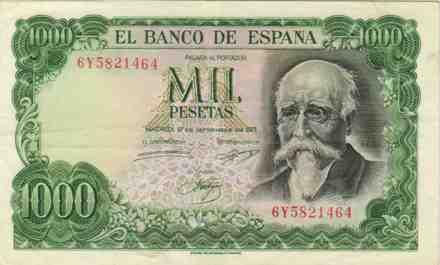
Khaldoun honored on 10 Tunisian Dinars
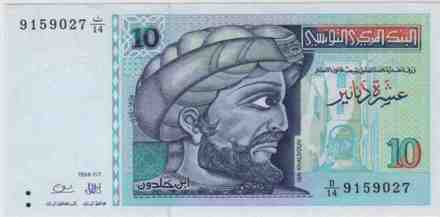
Alhazen featured on 10 Iraqi Dinars
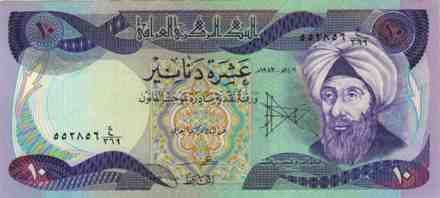
Avicenna has appeared on 20 Tajikistani Somoni
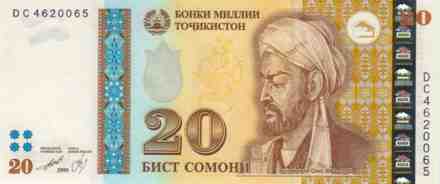
Alpharabius has appeared on a series of Kazakhstan Tenge
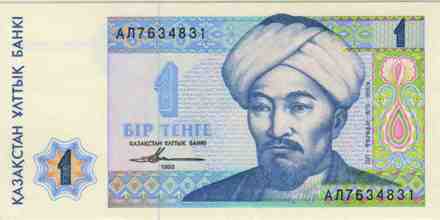
Valvasor on 20 Slovenian Tolars
Janez Vajkard Valvasor (1641 - 1693) was a Slovenian nobleman, a scholar and polymath, and a Fellow of The Royal Society. He was an authority on Hydrology and geophysics.
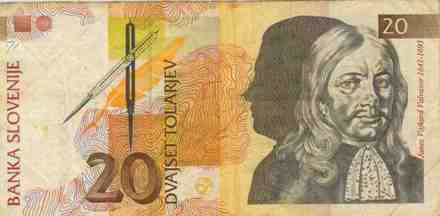
Planck featured on German 2 Mark
Max Planck (1858 – 1947) was a German physicist. He is considered to be the founder of the quantum theory, and thus one of the most important physicists of the twentieth century. Planck was awarded the Nobel Prize in Physics in 1918. In 1894 Planck turned his attention to the problem of black-body radiation. He had been commissioned by electric companies to create maximum light from light bulbs with minimum energy. The Planck Postulate E = h.v was introduced by Planck in his derivation of his law of black body radiation in 1900
Rutherford honored on 100 New Zealand Dollars
Ernest Rutherford, (1871–1937) was a British chemist and physicist who became known as the father of nuclear physics. He discovered the concept of radioactive half life, proved that radioactivity involved the transmutation of one chemical element to another, and also differentiated and named alpha and beta radiation. He was awarded the Nobel Prize in Chemistry in 1908 "for his investigations into the disintegration of the elements, and the chemistry of radioactive substances". In 1911, he postulated that atoms have their positive charge concentrated in a very small nucleus, and thereby pioneered the Rutherford model, or planetary, model of the atom, through his discovery and interpretation of Rutherford scattering in his gold foil experiment. He is widely credited with first splitting the atom in 1917.
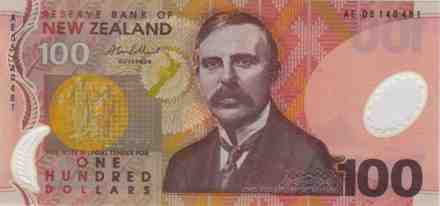
Schrodinger honored on 1000 Austrian Schillings
Erwin Schrödinger (1887 – 1961) was an Austrian theoretical physicist who achieved fame for his contributions to quantum mechanics, especially the Schrödinger equation, for which he received the Nobel Prize in 1933. In 1935, after extensive correspondence with personal friend Albert Einstein, he proposed the Schrödinger's cat thought experiment. One of Schrödinger's lesser-known areas of scientific contribution was his work on color, color perception, and colourimetry.
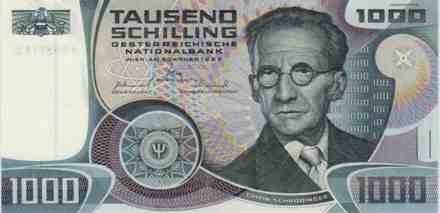
Bohr on 500 Danish Kroner
Niels Bohr (1885 –1962) was a Danish physicist who made foundational contributions to understanding atomic structure and quantum mechanics, for which he received the Nobel Prize in Physics in 1922. He was part of a team of physicists working on the Manhattan Project. The Bohr model of the atom, the theory that electrons travel in discrete orbits around the atom's nucleus and the shell model of the atom, where the chemical properties of an element are determined by the electrons in the outermost orbit are theories he developed. Bohr has been described as one of the most influential physicists of the 20th century. Bohr’s son also won the Nobel prize for Physics in 1975.
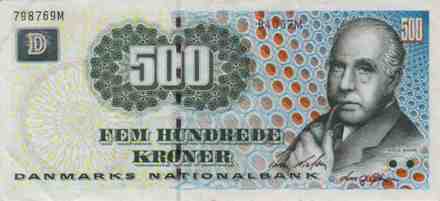
Einstein on 5 Israeli Lirot
Albert Einstein (1879–1955) was a German - born Swiss - American theoretical physicist, philosopher and author who is widely regarded as one of the most influential and best known scientists and intellectuals of all time. He is often regarded as the father of modern physics. He received the 1921 Nobel Prize in Physics "for his services to Theoretical Physics, and especially for his discovery of the law of the photoelectric effect."
His many contributions to physics include the special and general theories of relativity, the photon theory and wave-particle duality, the quantum theory of atomic motion in solids, the zero-point energy concept etc.

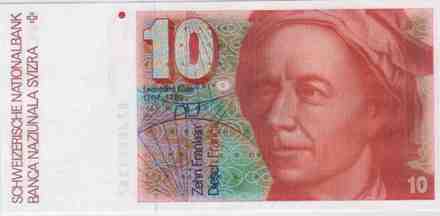
Carl Friedrich Gauss (1777 – 1855) was a German mathematician and scientist who contributed significantly to many fields, including number theory, statistics, analysis, differential geometry, geophysics, electrostatics, astronomy and optics.
The CGS unit for magnetic flux density was named gauss in his honour and so were the crater Gauss on the Moon and Asteroid 1001 Gaussia.
Leonhard Euler
(pronounced Oiler)
(1707 –1783) was a pioneering Swiss mathematician and
physicist who made important discoveries in fields as diverse as
infinitesimal calculus and graph theory. He also introduced much of the
modern mathematical terminology and notation, particularly for mathematical
analysis, such as the notion of a mathematical function.